Influences of the Runoff Partition Method on the Flexible Hybrid Runoff Generation Model for Flood Prediction
Abstract
:1. Introduction
2. Materials and Methods
2.1. Construction of Flexible Hybrid Runoff Generation Method
2.2. Construction of Runoff Partition Method
2.2.1. Two-Source Runoff Partition Method
2.2.2. Improved Two-Source Runoff Partition Method
2.2.3. Three-Source Runoff Partition Method
2.3. Hydrological Modeling Framework
2.4. Model Calibration and Evaluation
3. Study Area and Data
4. Results
4.1. Model Calibration and Performance Evaluation for the Continuous Flow Discharge
4.2. Performances of Simulated Results of Flood Events
4.3. Comparisons of Runoff Components for the Four Runoff Partition Strategies
5. Discussion
5.1. Discussion on Model Performance and Applicability
5.2. Discussion on the Nonlinear Components of the Four Strategies
6. Conclusions
- (1)
- Strategy P3 and P4 outperform other strategies, followed by Strategy S2. And Strategy P1 with no runoff partition module cannot reflect the actual conditions of the watershed;
- (2)
- Although the performance of Strategy P4 is good, it is not applicable to the flexible hybrid runoff generation models because it overestimates the surface runoff and almost ignores the subsurface stormflow runoff;
- (3)
- Strategy P3 is a compromise between strategies P2 and P4. It retains the advantages of the free reservoir in Strategy P4 and considers the heterogeneity of the watershed;
- (4)
- The runoff partition method is of great influence on the performances of the flexible hybrid runoff generation model. Given that most watersheds are dominated by a mixed runoff generation mechanism rather than a single runoff generation mechanism, our study has great practical value for hydrological modeling and flood prediction.
Author Contributions
Funding
Data Availability Statement
Acknowledgments
Conflicts of Interest
References
- Zhang, L.; Hu, C.; Jian, S.; Wu, Q.; Ran, G.; Xu, Y. Identifying dominant component of runoff yield processes: A case study in a sub-basin of the middle Yellow River. Hydrol. Res. 2021, 52, 1033–1047. [Google Scholar] [CrossRef]
- Yi, B.; Chen, L.; Liu, Y.; Guo, H.; Leng, Z.; Gan, X.; Xie, T.; Mei, Z. Hydrological modelling with an improved flexible hybrid runoff generation strategy. J. Hydrol. 2023, 620, 129457. [Google Scholar] [CrossRef]
- Shen, Y.J.; Liu, D.D.; Yin, J.B.; Xiong, L.H.; Liu, P. Integrating hybrid runoff generation mechanism into variable infiltration capacity model to facilitate hydrological simulations. Stoch. Environ. Res. Risk Assess. 2020, 34, 2139–2157. [Google Scholar] [CrossRef]
- Wang, W.; Liu, J.; Xu, B.; Li, C.; Liu, Y.; Yu, F. A WRF/WRF-Hydro coupling system with an improved structure for rainfall-runoff simulation with mixed runoff generation mechanism. J. Hydrol. 2022, 612, 128049. [Google Scholar] [CrossRef]
- Liu, Y.; Zhang, K.; Li, Z.; Liu, Z.; Wang, J.; Huang, P. A hybrid runoff generation modelling framework based on spatial combination of three runoff generation schemes for semi-humid and semi-arid watersheds. J. Hydrol. 2020, 590, 125440. [Google Scholar] [CrossRef]
- Yao, C.; Zhang, K.; Yu, Z.; Li, Z.; Li, Q. Improving the flood prediction capability of the Xinanjiang model in ungauged nested catchments by coupling it with the geomorphologic instantaneous unit hydrograph. J. Hydrol. 2014, 517, 1035–1048. [Google Scholar] [CrossRef]
- Li, Z.J.; Yao, C.; Kong, X.G. The Improved Xinanjiang model. J. Hydrodyn. Ser. B 2005, 17, 746–751. [Google Scholar] [CrossRef]
- Bao, W.; Wang, C. Vertically-mixed runoff model and its application. Hydrology 1997, 3, 18–21. [Google Scholar] [CrossRef]
- Liang, X.; Xie, Z. A new surface runoff parameterization with subgrid-scale soil heterogeneity for land surface models. Adv. Water Resour. 2001, 24, 1173–1193. [Google Scholar] [CrossRef]
- Euser, T.; Winsemius, H.C.; Hrachowitz, M.; Fenicia, F.; Uhlenbrook, S.; Savenije, H.H.G. A framework to assess the realism of model structures using hydrological signatures. Hydrol. Earth Syst. Sci. 2013, 17, 1893–1912. [Google Scholar] [CrossRef] [Green Version]
- Zhang, K.; Xue, X.; Hong, Y.; Gourley, J.J.; Lu, N.; Wan, Z.; Hong, Z.; Wooten, R. iCRESTRIGRS: A coupled modeling system for cascading flood–landslide disaster forecasting. Hydrol. Earth Syst. Sci. 2016, 20, 5035–5048. [Google Scholar] [CrossRef] [Green Version]
- Huang, P.N.; Li, Z.J.; Chen, J.; Li, Q.L.; Yao, C. Event-based hydrological modeling for detecting dominant hydrological process and suitable model strategy for semi-arid catchments. J. Hydrol. 2016, 542, 292–303. [Google Scholar] [CrossRef]
- Bai, P.; Liu, X.; Yang, T.; Liang, K.; Liu, C. Evaluation of streamflow simulation results of land surface models in GLDAS on the Tibetan plateau. J. Geophys. Res. Atmos. 2016, 121, 12180–12197. [Google Scholar] [CrossRef]
- Qi, J.; Lee, S.; Zhang, X.; Yang, Q.; McCarty, G.W.; Moglen, G.E. Effects of surface runoff and infiltration partition methods on hydrological modeling: A comparison of four schemes in two watersheds in the Northeastern US. J. Hydrol. 2020, 581, 124415. [Google Scholar] [CrossRef]
- Kling, H.; Nachtnebel, H.P. A method for the regional estimation of runoff separation parameters for hydrological modelling. J. Hydrol. 2009, 364, 163–174. [Google Scholar] [CrossRef]
- Haberlandt, U.; Klöcking, B.; Krysanova, V.; Becker, A. Regionalisation of the base flow index from dynamically simulated flow components—A case study in the Elbe River Basin. J. Hydrol. 2001, 248, 35–53. [Google Scholar] [CrossRef]
- Naef, F.; Scherrer, S.; Weiler, M. A process based assessment of the potential to reduce flood runoff by land use change. J. Hydrol. 2002, 267, 74–79. [Google Scholar] [CrossRef]
- Gurtz, J.; Zappa, M.; Jasper, K.; Lang, H.; Verbunt, M.; Badoux, A.; Vitvar, T. A comparative study in modelling runoff and its components in two mountainous catchments. Hydrol. Process. 2003, 17, 297–311. [Google Scholar] [CrossRef]
- Ardekani, A.A.; Sabzevari, T.; Haghighi, A.T.; Petroselli, A. Separation of surface flow from subsurface flow in catchments using runoff coefficient. Acta Geophys. 2021, 69, 2363–2376. [Google Scholar] [CrossRef]
- Maier, F.; van Meerveld, I.; Weiler, M. Long-Term Changes in Runoff Generation Mechanisms for Two Proglacial Areas in the Swiss Alps II: Subsurface Flow. Water Resour. Res. 2021, 57, e2021WR030223. [Google Scholar] [CrossRef]
- Wu, J.; Li, H.; Zhou, J.; Tai, S.; Wang, X. Variation of Runoff and Runoff Components of the Upper Shule River in the Northeastern Qinghai–Tibet Plateau under Climate Change. Water 2021, 13, 3357. [Google Scholar] [CrossRef]
- Appels, W.M.; Bogaart, P.W.; van der Zee, S.E.A.T.M. Feedbacks Between Shallow Groundwater Dynamics and Surface Topography on Runoff Generation in Flat Fields. Water Resour. Res. 2017, 53, 10336–10353. [Google Scholar] [CrossRef] [Green Version]
- Zhao, R.J. The Xinanjiang model applied in China. J. Hydrol. 1992, 135, 371–381. [Google Scholar] [CrossRef]
- Kirkby Mike, J. Hillslope form and process: History 1960–2000+. Geol. Soc. Lond. Mem. 2022, 58, 213–225. [Google Scholar] [CrossRef]
- Li, H.; Zhang, Y.; Chiew, F.H.S.; Xu, S. Predicting runoff in ungauged catchments by using Xinanjiang model with MODIS leaf area index. J. Hydrol. 2009, 370, 155–162. [Google Scholar] [CrossRef]
- Tong, B.; Li, Z.; Yao, C.; Wang, J.; Huang, Y. Derivation of the Spatial Distribution of Free Water Storage Capacity Based on Topographic Index. Water 2018, 10, 1407. [Google Scholar] [CrossRef] [Green Version]
- Hao, F.; Sun, M.; Geng, X.; Huang, W.; Ouyang, W. Coupling the Xinanjiang model with geomorphologic instantaneous unit hydrograph for flood forecasting in northeast China. Int. Soil Water Conserv. Res. 2015, 3, 66–76. [Google Scholar] [CrossRef] [Green Version]
- Zhou, Q.; Chen, L.; Singh, V.P.; Zhou, J.; Chen, X.; Xiong, L. Rainfall-runoff simulation in karst dominated areas based on a coupled conceptual hydrological model. J. Hydrol. 2019, 573, 524–533. [Google Scholar] [CrossRef]
- Pelletier, A.; Andréassian, V. Hydrograph separation: An impartial parametrisation for an imperfect method. Hydrol. Earth Syst. Sci. 2020, 24, 1171–1187. [Google Scholar] [CrossRef] [Green Version]
- Huang, P.; Li, Z.; Yao, C.; Li, Q.; Yan, M. Spatial Combination Modeling Framework of Saturation-Excess and Infiltration-Excess Runoff for Semihumid Watersheds. Adv. Meteorol. 2016, 2016, 5173984. [Google Scholar] [CrossRef] [Green Version]
- Bao, W.; Zhao, L. Application of Linearized Calibration Method for Vertically Mixed Runoff Model Parameters. J. Hydrol. Eng. 2014, 19, 04014007. [Google Scholar] [CrossRef]
- Green, W.H.; Ampt, G.A. Studies on soil physics. The flow of air and water through soils. J. Agric. Sci. 1911, 4, 11–24. [Google Scholar] [CrossRef]
- Philip, J.R. The theory of infiltration: 4. Sorptivity and algebraic infiltration equations. Soil Sci. 1957, 84, 257–264. [Google Scholar] [CrossRef]
- Beven, K.; Robert, E. Horton’s perceptual model of infiltration processes. Hydrol. Process. 2004, 18, 3447–3460. [Google Scholar] [CrossRef]
- Huo, W.B.; Li, Z.J.; Zhang, K.; Wang, J.F.; Yao, C. GA-PIC: An improved Green-Ampt rainfall-runoff model with a physically based infiltration distribution curve for semi-arid basins. J. Hydrol. 2020, 586, 124900. [Google Scholar] [CrossRef]
- Chen, Y.; Shi, P.; Qu, S.; Ji, X.; Zhao, L.; Gou, J.; Mou, S. Integrating XAJ Model with GIUH Based on Nash Model for Rainfall-Runoff Modelling. Water 2019, 11, 772. [Google Scholar] [CrossRef] [Green Version]
- Duan, Q.; Sorooshian, S.; Gupta, V. Effective and efficient global optimization for conceptual rainfall-runoff models. Water Resour. Res. 1992, 28, 1015–1031. [Google Scholar] [CrossRef]
- Brunner, M.I.; Swain, D.L.; Wood, R.R.; Willkofer, F.; Done, J.M.; Gilleland, E.; Ludwig, R. An extremeness threshold determines the regional response of floods to changes in rainfall extremes. Commun. Earth Environ. 2021, 2, 173. [Google Scholar] [CrossRef]
- Yi, B.; Chen, L.; Zhang, H.; Singh, V.P.; Jiang, P.; Liu, Y.; Guo, H.; Qiu, H. A time-varying distributed unit hydrograph method considering soil moisture. Hydrol. Earth Syst. Sci. 2022, 26, 5269–5289. [Google Scholar] [CrossRef]
- Pilz, T.; Francke, T.; Baroni, G.; Bronstert, A. How to Tailor My Process-Based Hydrological Model? Dynamic Identifiability Analysis of Flexible Model Structures. Water Resour. Res. 2020, 56, e2020WR028042. [Google Scholar] [CrossRef]
- Katwal, R.; Li, J.; Zhang, T.; Hu, C.; Rafique, M.A.; Zheng, Y. Event-based and continous flood modeling in Zijinguan watershed, Northern China. Nat. Hazards 2021, 108, 733–753. [Google Scholar] [CrossRef]
- Beven, K. A manifesto for the equifinality thesis. J. Hydrol. 2006, 320, 18–36. [Google Scholar] [CrossRef] [Green Version]
- Wang, J.; Wang, G.; Elmahdi, A.; Bao, Z.; Yang, Q.; Shu, Z.; Song, M. Comparison of hydrological model ensemble forecasting based on multiple members and ensemble methods. Open Geosci. 2021, 13, 401–415. [Google Scholar] [CrossRef]
- Hao, G.; Li, J.; Song, L.; Li, H.; Li, Z. Comparison between the TOPMODEL and the Xin’anjiang model and their application to rainfall runoff simulation in semi-humid regions. Environ. Earth Sci. 2018, 77, 279. [Google Scholar] [CrossRef]
- Li, D.; Liang, Z.; Zhou, Y.; Li, B.; Fu, Y. Multicriteria assessment framework of flood events simulated with vertically mixed runoff model in semiarid catchments in the middle Yellow River. Nat. Hazards Earth Syst. Sci. 2019, 19, 2027–2037. [Google Scholar] [CrossRef] [Green Version]
- Gowdish, L.; Muñoz-Carpena, R. An Improved Green–Ampt Infiltration and Redistribution Method for Uneven Multistorm Series. Vadose Zone J. 2009, 8, 470–479. [Google Scholar] [CrossRef]
- Liu, Y.; Cui, Z.; Huang, Z.; López-Vicente, M.; Wu, G.-L. Influence of soil moisture and plant roots on the soil infiltration capacity at different stages in arid grasslands of China. CATENA 2019, 182, 104147. [Google Scholar] [CrossRef]
- Yang, M.; Zhang, Y.; Pan, X. Improving the Horton infiltration equation by considering soil moisture variation. J. Hydrol. 2020, 586, 124864. [Google Scholar] [CrossRef]
- Basu, B.; Morrissey, P.; Gill, L.W. Application of Nonlinear Time Series and Machine Learning Algorithms for Forecasting Groundwater Flooding in a Lowland Karst Area. Water Resour. Res. 2022, 58, e2021WR029576. [Google Scholar] [CrossRef]
- Ghonchepour, D.; Sadoddin, A.; Bahremand, A.; Croke, B.; Jakeman, A.; Salmanmahiny, A. A methodological framework for the hydrological model selection process in water resource management projects. Nat. Resour. Model. 2021, 34, e12326. [Google Scholar] [CrossRef]
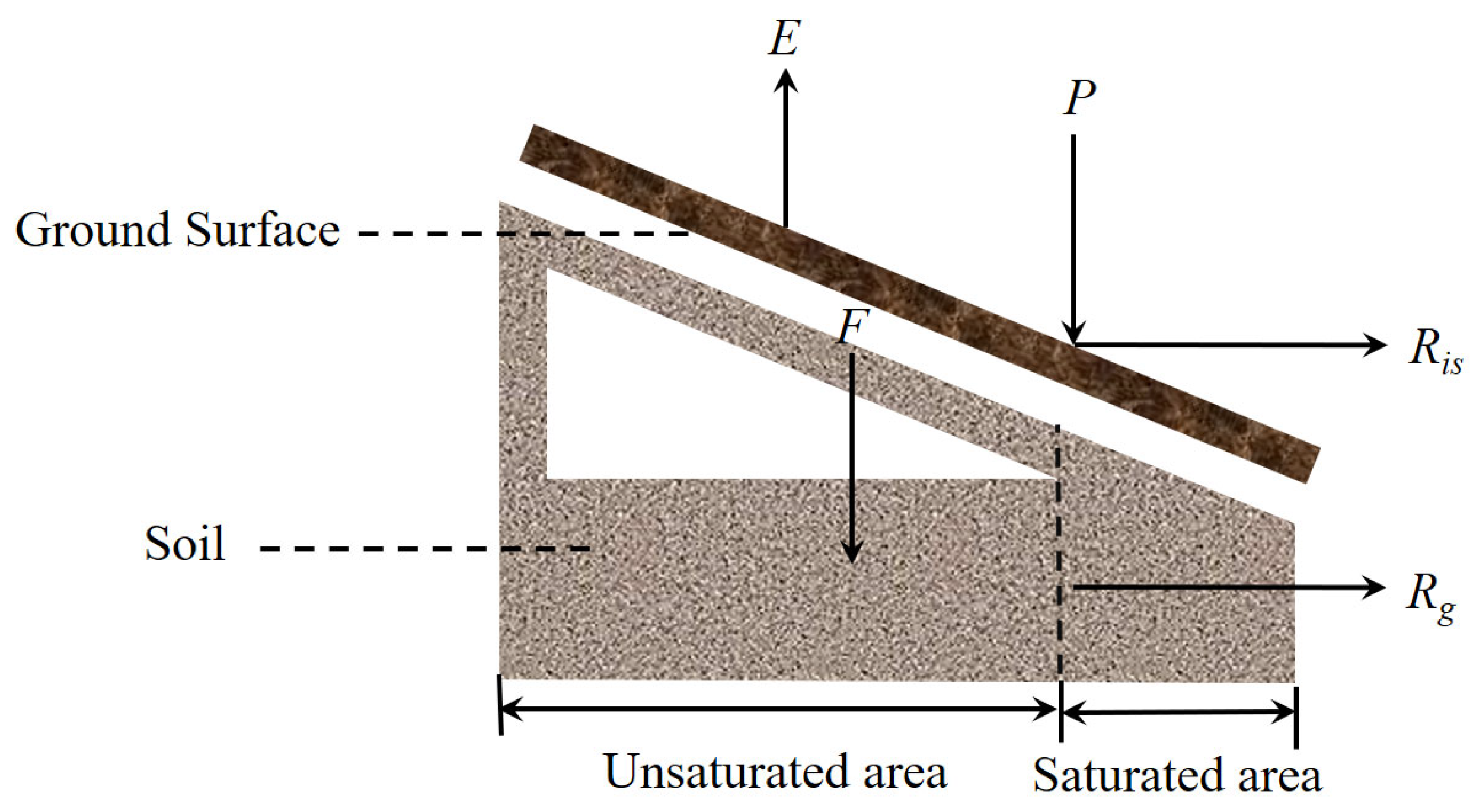
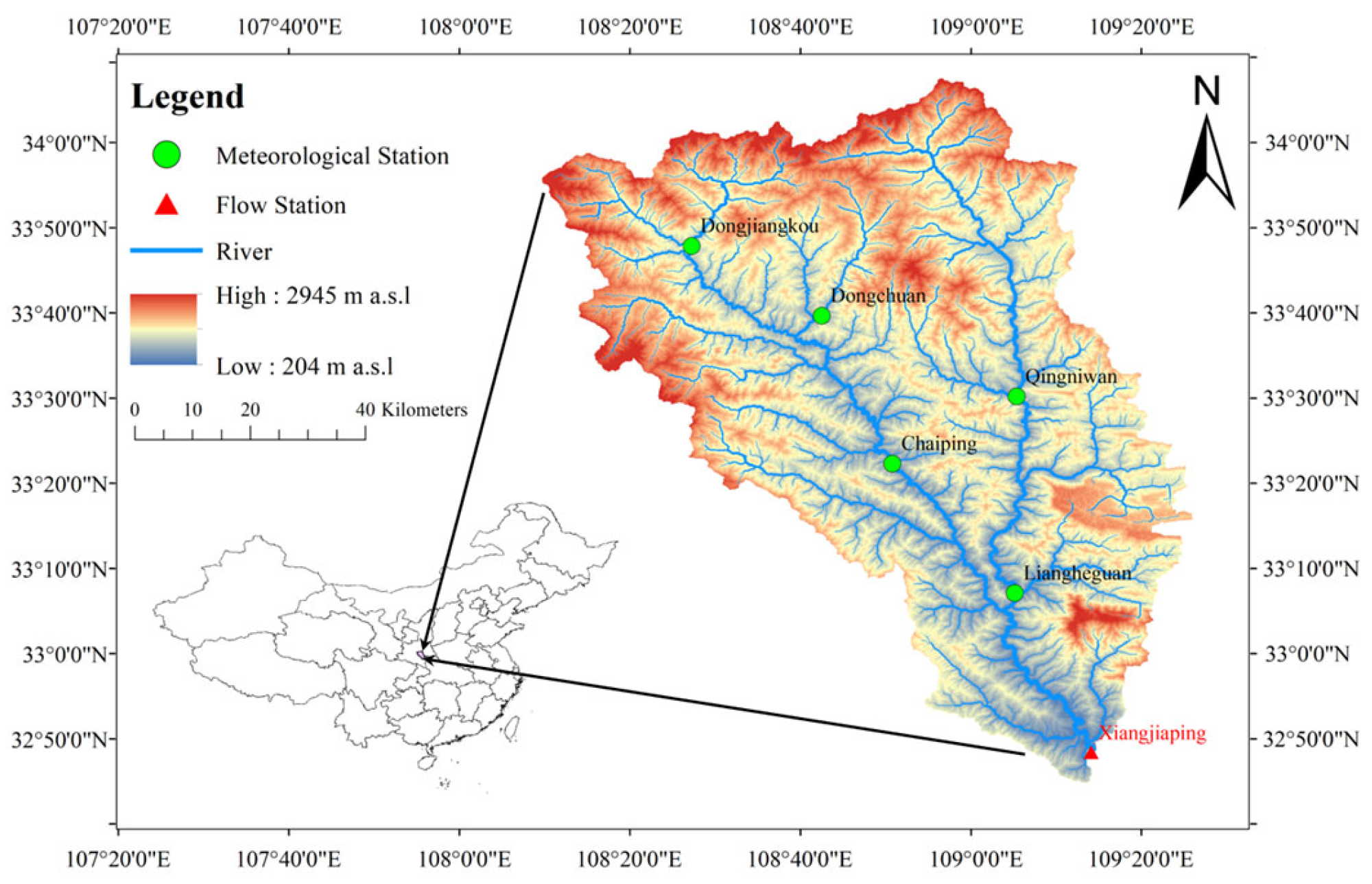
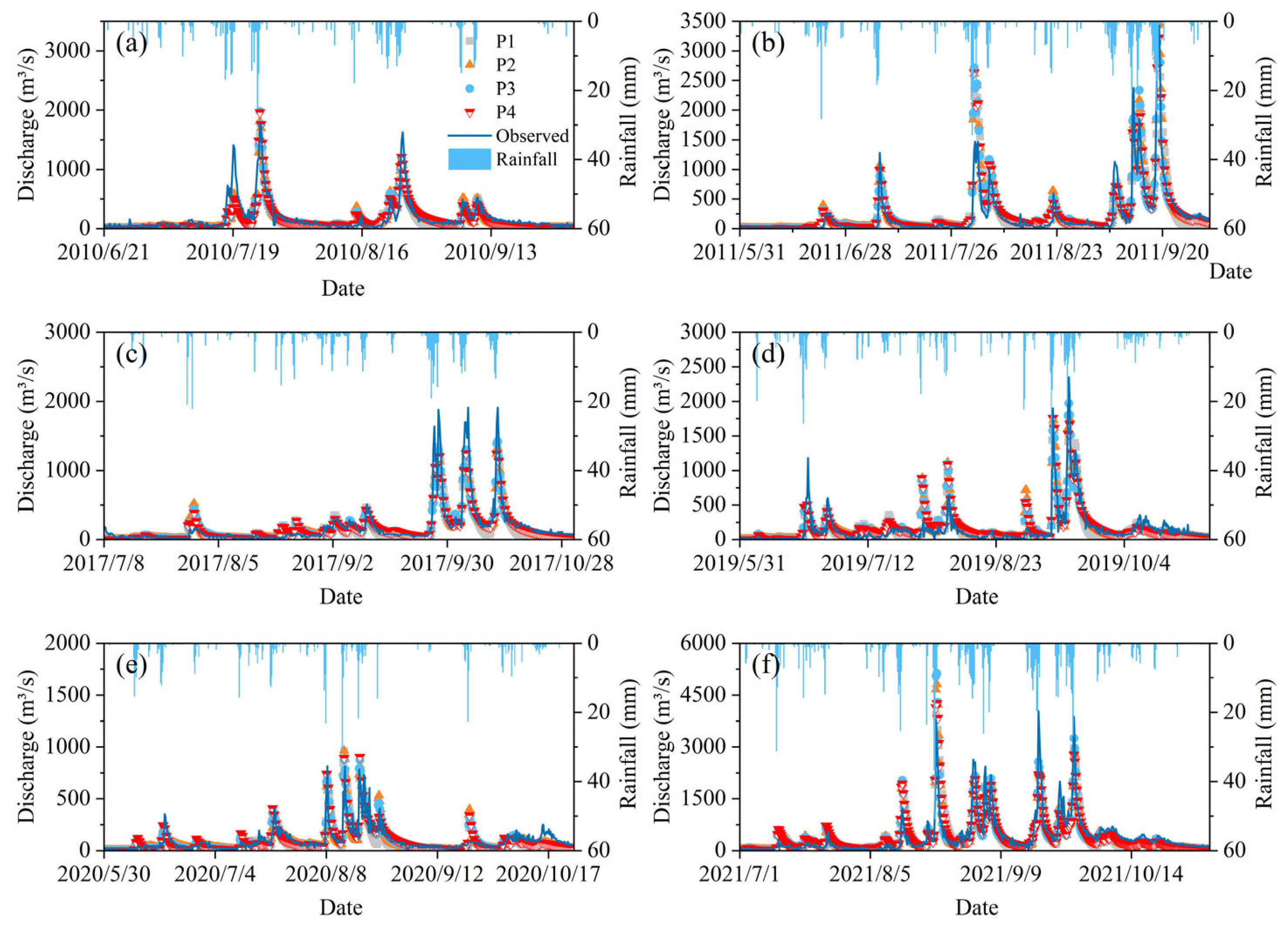
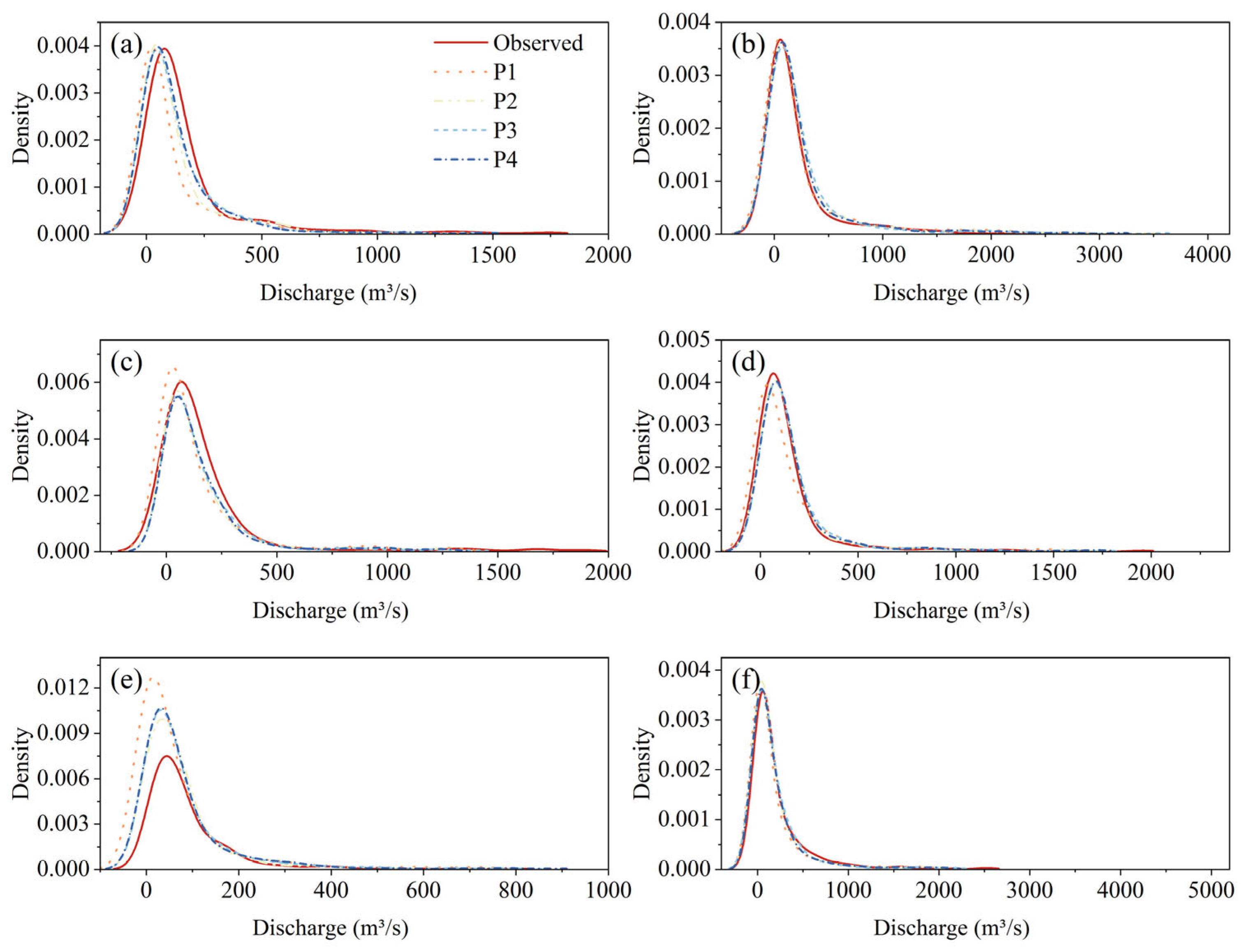
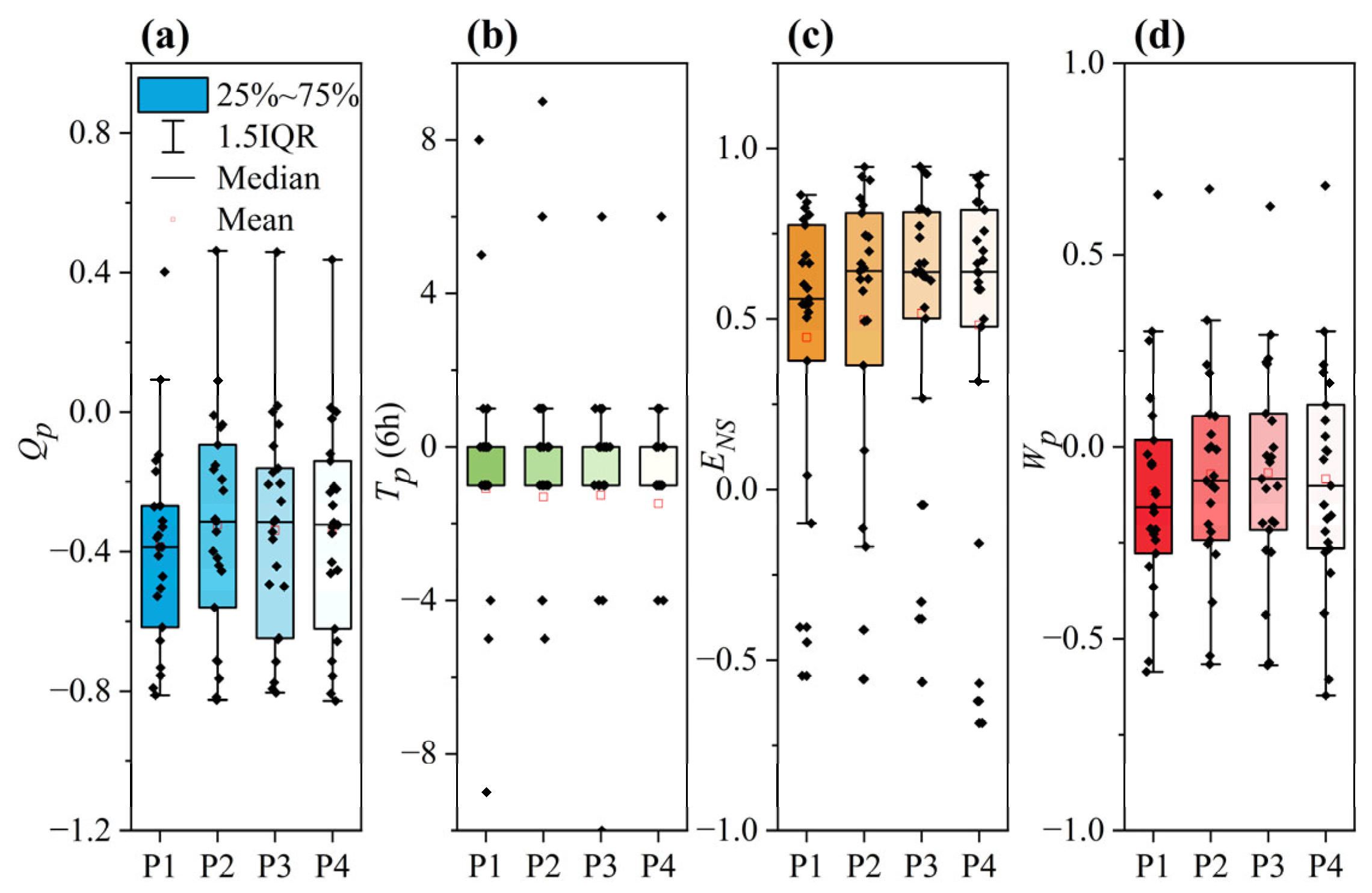

| Notation | Description | Units |
|---|---|---|
| Rainfall | mm | |
| Evapotranspiration | mm | |
| Infiltration of excess surface runoff | mm | |
| Saturation of excess subsurface runoff | mm | |
| Infiltration from the ground surface to the soil | mm |
| Descriptions | Parameters | Strategies | |||
|---|---|---|---|---|---|
| P1 | P2 | P3 | P4 | ||
| Average capacity of free water in the surface soil layer | SM (mm) | ||||
| The distribution exponent of free water capacity | B (unitless) | ||||
| Outflow coefficients of the free water storage to subsurface stormflow | KI (unitless) | ||||
| Outflow coefficients of the free water storage to subsurface flow | KG (unitless) | ||||
| Constant infiltration rate | fc (mm) | ||||
| Exponential of the distribution to the steady infiltration rate. | B3 (unitless) | ||||
| Runoff Components | Strategies | |||
|---|---|---|---|---|
| P1 | P2 | P3 | P4 | |
| Saturation-excess surface runoff | ||||
| Infiltration-excess surface runoff | ||||
| Subsurface stormflow runoff | ||||
| Subsurface runoff | ||||
| Criteria | Strategies | Calibration Period | Validation Period | |||||||||
|---|---|---|---|---|---|---|---|---|---|---|---|---|
| 2010 | 2011 | 2012 | 2013 | 2014 | 2015 | 2017 | 2018 | 2019 | 2020 | 2021 | ||
| ENS | P1 | 0.75 | 0.81 | 0.59 | 0.70 | 0.67 | 0.38 | 0.84 | 0.55 | 0.73 | 0.56 | 0.74 |
| P2 | 0.78 | 0.85 | 0.65 | 0.70 | 0.69 | 0.49 | 0.84 | 0.67 | 0.76 | 0.68 | 0.80 | |
| P3 | 0.77 | 0.87 | 0.66 | 0.70 | 0.73 | 0.48 | 0.85 | 0.60 | 0.81 | 0.72 | 0.82 | |
| P4 | 0.78 | 0.85 | 0.68 | 0.73 | 0.72 | 0.48 | 0.85 | 0.58 | 0.78 | 0.69 | 0.81 | |
| EKG | P1 | 0.59 | 0.88 | 0.61 | 0.69 | 0.74 | 0.65 | 0.68 | 0.40 | 0.86 | 0.64 | 0.79 |
| P2 | 0.68 | 0.85 | 0.64 | 0.80 | 0.80 | 0.66 | 0.67 | 0.51 | 0.88 | 0.77 | 0.82 | |
| P3 | 0.68 | 0.87 | 0.64 | 0.83 | 0.83 | 0.66 | 0.67 | 0.44 | 0.89 | 0.79 | 0.83 | |
| P4 | 0.69 | 0.87 | 0.64 | 0.83 | 0.83 | 0.69 | 0.68 | 0.41 | 0.88 | 0.77 | 0.83 | |
| RMSE | P1 | 132.5 | 192.6 | 108.8 | 56.2 | 201.6 | 81.2 | 122.2 | 103.2 | 133.6 | 74.7 | 231.7 |
| P2 | 123.2 | 175.5 | 100.6 | 56.3 | 193.1 | 73.3 | 120.9 | 87.8 | 125.5 | 64.0 | 202.9 | |
| P3 | 126.0 | 160.9 | 99.3 | 55.7 | 181.1 | 74.1 | 118.5 | 96.6 | 112.9 | 59.2 | 194.6 | |
| P4 | 123.1 | 174.7 | 97.1 | 53.0 | 183.6 | 74.0 | 115.6 | 99.6 | 122.3 | 62.8 | 200.0 | |
Disclaimer/Publisher’s Note: The statements, opinions and data contained in all publications are solely those of the individual author(s) and contributor(s) and not of MDPI and/or the editor(s). MDPI and/or the editor(s) disclaim responsibility for any injury to people or property resulting from any ideas, methods, instructions or products referred to in the content. |
© 2023 by the authors. Licensee MDPI, Basel, Switzerland. This article is an open access article distributed under the terms and conditions of the Creative Commons Attribution (CC BY) license (https://creativecommons.org/licenses/by/4.0/).
Share and Cite
Yi, B.; Chen, L.; Yang, B.; Li, S.; Leng, Z. Influences of the Runoff Partition Method on the Flexible Hybrid Runoff Generation Model for Flood Prediction. Water 2023, 15, 2738. https://doi.org/10.3390/w15152738
Yi B, Chen L, Yang B, Li S, Leng Z. Influences of the Runoff Partition Method on the Flexible Hybrid Runoff Generation Model for Flood Prediction. Water. 2023; 15(15):2738. https://doi.org/10.3390/w15152738
Chicago/Turabian StyleYi, Bin, Lu Chen, Binlin Yang, Siming Li, and Zhiyuan Leng. 2023. "Influences of the Runoff Partition Method on the Flexible Hybrid Runoff Generation Model for Flood Prediction" Water 15, no. 15: 2738. https://doi.org/10.3390/w15152738
APA StyleYi, B., Chen, L., Yang, B., Li, S., & Leng, Z. (2023). Influences of the Runoff Partition Method on the Flexible Hybrid Runoff Generation Model for Flood Prediction. Water, 15(15), 2738. https://doi.org/10.3390/w15152738








